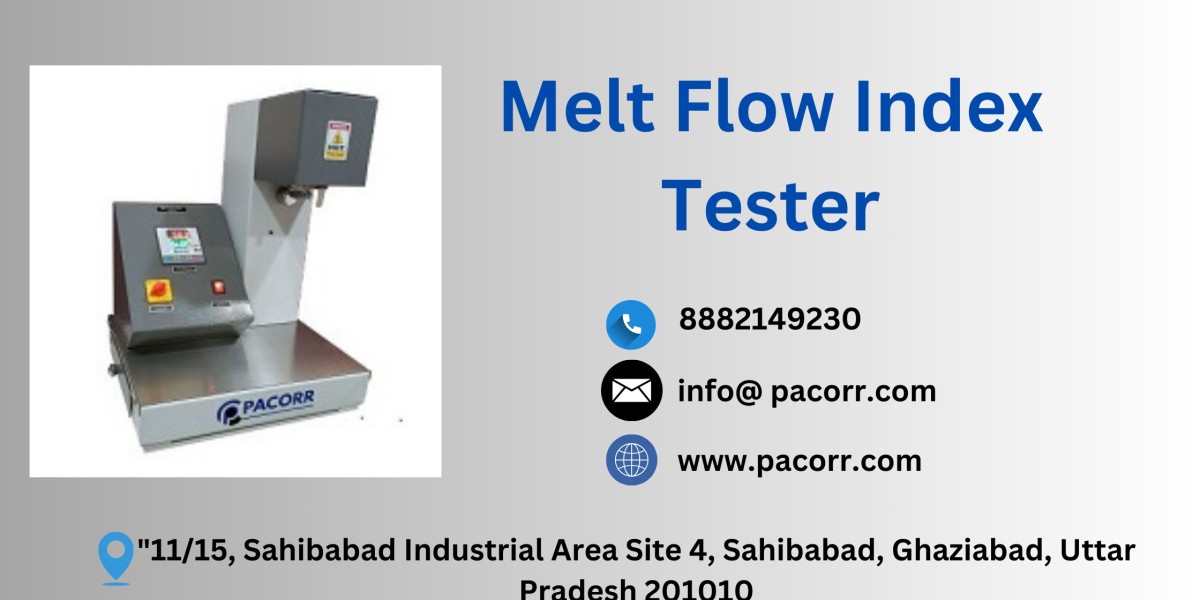Introduction
In the plastics industry, maintaining the quality and consistency of materials is crucial. The Melt Flow Index (MFI) Tester is an essential tool that helps manufacturers ensure their products meet these high standards. This article delves into the importance of the Melt Flow Index Tester, its working principles, applications, and benefits.
What is a Melt Flow Index Tester?
A Melt Flow Index Testing measures the rate of extrusion of thermoplastic polymers. This rate, known as the Melt Flow Rate (MFR), indicates the ease of flow of the molten polymer. The test provides valuable data about the material's viscosity and its behavior under specific conditions, which is critical for quality control and product development in the plastics industry.
Working Principle
The MFI Tester operates on a straightforward principle. A polymer sample is loaded into a heated barrel, where it melts. The molten polymer is then extruded through a capillary die by applying a specified weight. The amount of polymer extruded in ten minutes is measured, providing the MFR value, usually expressed in grams per ten minutes (g/10 min).
Key Components of the Melt Flow Index Tester
- Heated Barrel: Maintains a constant temperature to melt the polymer.
- Capillary Die: A precise opening through which the molten polymer is extruded.
- Piston and Weight System: Applies the required force to push the polymer through the die.
- Timer and Scale: Measures the time and weight of the extruded polymer.
Applications of Melt Flow Index Testing
The MFI Tester is widely used in various sectors within the plastics industry:
- Quality Control: Ensures that materials meet specific flow characteristics, crucial for consistent product performance.
- Material Selection: Helps in choosing the right polymer for specific applications based on flow properties.
- Research and Development: Aids in developing new materials with desired flow characteristics.
- Compliance: Ensures that products meet industry standards and regulatory requirements.
Benefits of Using a Melt Flow Index Tester
- Precision: Provides accurate and repeatable measurements of polymer flow properties.
- Efficiency: Fast and easy to operate, allowing for high throughput in quality control processes.
- Versatility: Suitable for a wide range of thermoplastic materials.
- Cost-Effective: Reduces waste by ensuring materials meet specifications before production.
Choosing the Right Melt Flow Index Tester
When selecting an MFI Tester, consider the following factors:
- Temperature Range: Ensure the tester can operate at the temperatures required for your materials.
- Load Capacity: Different testers offer various weight capacities; choose one that meets your testing needs.
- Precision and Accuracy: Look for testers with high precision and repeatability.
- Ease of Use: User-friendly interfaces and easy maintenance are essential for efficient operation.
Conclusion
The Melt Flow Index Tester is a vital instrument in the plastics industry, providing critical data that ensures the quality and consistency of polymer products. By understanding its working principles, applications, and benefits, manufacturers can make informed decisions to maintain high standards in their production processes. Investing in a reliable MFI Tester is a step towards achieving superior product quality and operational efficiency.
Frequently Asked Questions (FAQ)
Q1: What is the Melt Flow Rate (MFR)? A1: The Melt Flow Rate (MFR) is the rate at which a polymer melts and flows through a capillary die under specific conditions, measured in grams per ten minutes (g/10 min).
Q2: Why is the Melt Flow Index important? A2: The Melt Flow Index provides valuable information about the viscosity and flow characteristics of a polymer, which are crucial for quality control, material selection, and product development.
Q3: How does temperature affect the Melt Flow Index? A3: Temperature significantly impacts the Melt Flow Teste. Higher temperatures reduce the viscosity of the polymer, increasing the flow rate, while lower temperatures have the opposite effect.
Q4: Can the Melt Flow Index Tester be used for all types of polymers? A4: The MFI Tester is suitable for a wide range of thermoplastic polymers. However, it's essential to ensure the tester's specifications match the requirements of the material being tested.
Q5: How often should the Melt Flow Index Tester be calibrated? A5: Regular calibration is essential to maintain accuracy. The frequency depends on the usage and the manufacturer's recommendations, but typically, it should be calibrated annually.
Q6: What standards are used for Melt Flow Index testing? A6: Common standards include ASTM D1238 and ISO 1133, which outline the procedures and conditions for conducting MFI tests.
Q7: Can the Melt Flow Index Tester be automated? A7: Yes, many modern MFI Testers offer automated features, such as automatic sample loading, extrusion, and data recording, enhancing efficiency and reducing operator error.
Q8: What maintenance is required for the Melt Flow Index Tester? A8: Regular cleaning of the barrel and die, checking the temperature control system, and ensuring the weights and piston are in good condition are essential maintenance tasks to ensure accurate results.
By understanding and utilizing the Melt Flow Index Testing effectively, manufacturers can ensure the quality and performance of their polymer products, meeting industry standards and customer expectations.








